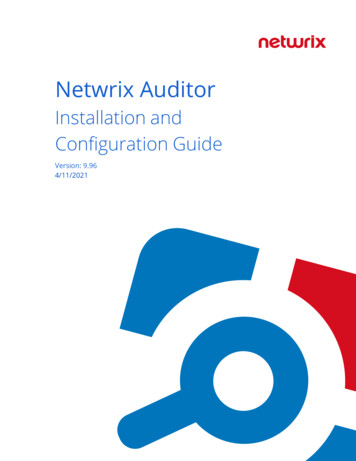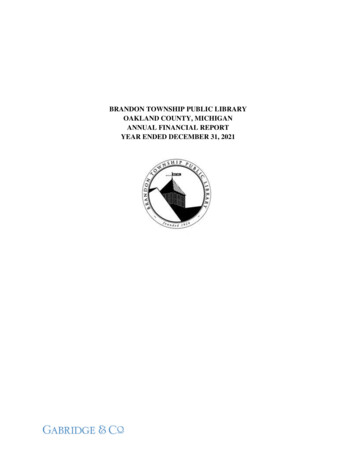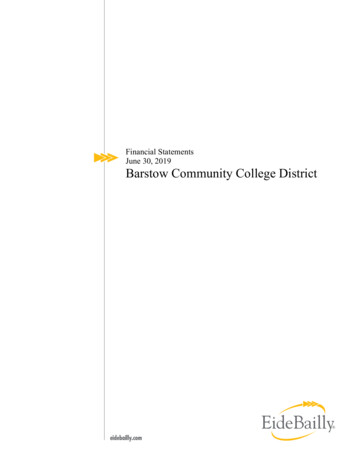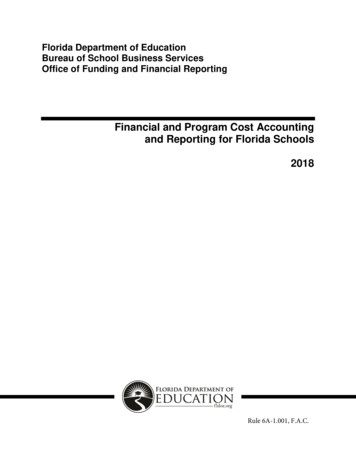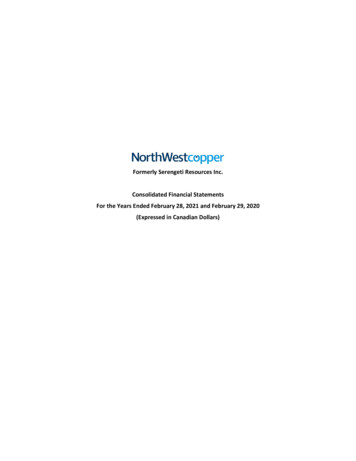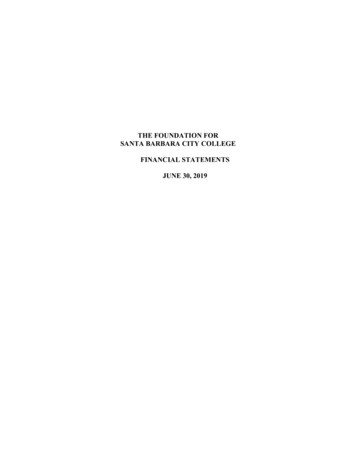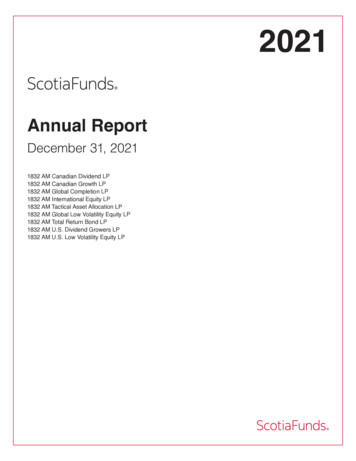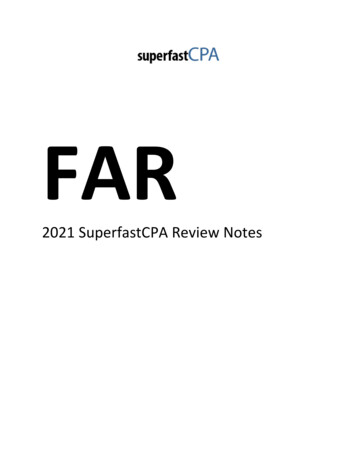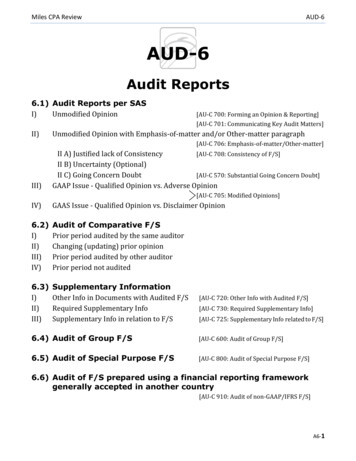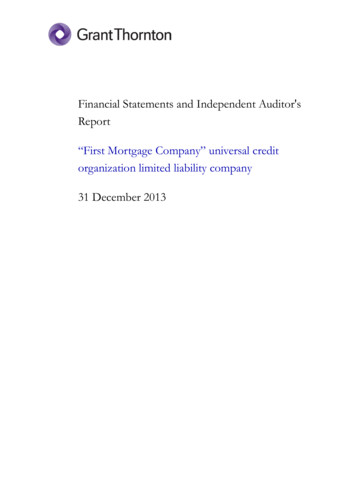
Transcription
Financial Statements and Independent Auditor'sReport“First Mortgage Company” universal creditorganization limited liability company31 December 2013
“First Mortgage Company” universal credit organization limited liability companyFinancial statements31 December 2013ContentsPageIndependent auditor’s report1Statement of profit or loss and other comprehensive income3Statement of financial position4Statement of changes in equity5Statement of cash flows6Accompanying notes to the financial statements7
Independent auditor’s report¶ñ³Ýà ÂáñÝÃáÝ ö ÀÐÐ, ù. ºñ»õ³Ý 0012ì³Õ³ñßÛ³Ý 8/1Ð. 374 10 260 964ü. 374 10 260 961Grant Thornton CJSC8/1 Vagharshyan Str.0012 Yerevan, ArmeniaT 374 10 260 964F 374 10 260 961www.grantthornton.amTo the Shareholders of “First Mortgage Company” universal credit organization limited liabilitycompany:We have audited the accompanying financial statements of “First Mortgage Company” universalcredit organization limited liability company (the “Company”), which comprise the statement offinancial position as of December 31, 2013, and the statement of profit or loss and othercomprehensive income, statement of changes in equity and statement of cash flows for the yearthen ended, and a summary of significant accounting policies and other explanatory information.Management’s ResponsibilityManagement is responsible for the preparation and fair presentation of these financial statementsin accordance with International Financial Reporting Standards, and for such internal control asmanagement determines is necessary to enable the preparation of financial statements that are freefrom material misstatement, whether due to fraud or error.Auditor’s ResponsibilityOur responsibility is to express an opinion on these financial statements based on our audit. Weconducted our audit in accordance with International Standards on Auditing. Those standardsrequire that we comply with ethical requirements and plan and perform the audit to obtainreasonable assurance about whether the financial statements are free from material misstatement.An audit involves performing procedures to obtain audit evidence about the amounts anddisclosures in the financial statements. The procedures selected depend on the auditor’s judgment,including the assessment of the risks of material misstatement of the financial statements, whetherdue to fraud or error. In making those risk assessments, the auditor considers internal controlrelevant to the entity’s preparation and fair presentation of the financial statements in order todesign audit procedures that are appropriate in the circumstances, but not for the purpose ofexpressing an opinion on the effectiveness of the entity’s internal control. An audit also includesevaluating the appropriateness of accounting policies used and the reasonableness of accountingestimates made by management, as well as evaluating the overall presentation of the financialstatements.Աáõ¹Çï, гñÏ»ñ, ÊáñÑñ¹³ïíáõÃÛáõÝAudit, Tax, Advisory¶ñ³Ýà ÂáñÝÃáÝ ÆÝûñÝ»ßÝÉÇ ³Ý¹³ÙMember of Grant Thornton International Ltd
“First Mortgage Company” universal credit organization limited liability companyFinancial statements31 December 20133Statement of profit and loss and othercomprehensive incomeIn thousand Armenian dramsNotesInterest and similar incomeInterest and similar expense66Net interest incomeFee and commission incomeFee and commission expense77Net fee and commission incomeGains less losses from foreign currencies transactionsOther incomeImpairment (charge)/reversal for credit lossesStaff costsDepreciation of property and equipmentAmortization of intangible assetsOther expenses8149161710Profit before income taxIncome tax expenseProfit for the yearOther comprehensive incomeTotal comprehensive income for the year11Year endedDecember 31, 2013Year endedDecember 31, 769)77,973121,170--77,973121,170The accompanying notes on pages 7 to 40 are an integral part of these financial statements.
“First Mortgage Company” universal credit organization limited liability companyFinancial statements31 December 20135Statement of changes in equityIn thousand Armenian dramsAs of January 1, 2012Charter capitalRetained earningsTotal730,000126,732856,732Dividends to participants-(93,179)(93,179)Transactions with owners-(93,179)(93,179)Profit for the year-121,170121,170Total comprehensive income for ds to participants-(100,000)(100,000)Transactions with 730,000132,696862,696As of December 31, 2012Profit for the yearTotal comprehensive income for theyearAs of December 31, 2013
“First Mortgage Company” universal credit organization limited liability companyFinancial statements31 December 20136Statement of cash flowsIn thousand Armenian dramsYear endedDecember 31, 2013Year endedDecember 31, 2012Cash flows from operating activitiesInterest receivedInterest paidFees and commissions receivedFees and commissions paidRealised gains less losses from transactions in foreign currenciesOther income receivedSalaries and benefits paidOther operating expenses paidCash flows from operating activities before changes inoperating assets and liabilitiesNet (increase)/decrease in operating assetsAmounts due to banksLoans to customersOther assetsNet increase/( decrease )in operating liabilitiesOther 172,830(358,167)10,46063(85,094)Income tax paid(1,350,843)(26,969)(259,971)(37,749)Net cash used in operating (92,296)1,467,086253,018Net increase/(decrease )in cash and cash equivalents86,822(46,983)Cash and cash equivalents at the beginning of the yearEffect of exchange rate changes on cash and cash equivalents32,629(1,940)78,1021,432Cash and cash equivalents at the end of the year (Note 12)117,51132,551Net cash used in operating activities before income taxCash flows from investing activitiesPurchase of property and equipmentDisposal of property and equipmentNet cash used in investing activitiesCash flows from financing activitiesDividends paid to shareholdersAmounts due from financial institutionsBorrowingsNet cash from financing activities
“First Mortgage Company” universal credit organization limited liability companyFinancial statements31 December 20137Accompanying notes to the financialstatements1Principal activities“First Mortgage Company” UCO LLC (the “Company”) is a limited liability company, which wasincorporated in 2004. The Company is regulated by the legislation of the Republic of Armenia (RA).The Company was registered on 13 April 2004 under license number 7, granted by the Central Bankof Armenia (the “CBA”). The Company is supervised by the CBA.The Company’s main activity is mortgage loan extension.The Company’s office is located in Yerevan. The registered office of the Company is located at: 10V. Sargsyan Str., N122, Yerevan, Republic of Armenia.2Armenian business environmentArmenia continues to undergo political and economic changes. As an emerging market, Armeniadoes not possess a developed business and regulatory infrastructure that generally exists in a moremature free market economy. In addition, economic conditions continue to limit the volume ofactivity in the financial markets, which may not be reflective of the values for financial instruments.The main obstacle to further economic development is a low level of economic and institutionaldevelopment, along with a centralized economic base.There are still uncertainties about the economic situation of countries collaborating with the RA,which may lead to the shortage of money transfers from abroad, as well as to the decline in theprices of mining products, upon which the economy of Armenia is significantly dependant. In timesof more severe market stress the situation of Armenian economy and of the Company may beexposed to deterioration. However, as the number of variables and assumptions involved in theseuncertainties is big, management cannot make a reliable estimate of the amounts by which thecarrying amounts of assets and liabilities of the Company may be affected.Accordingly, the financial statements of the Company do not include the effects of adjustments,which might have been considered necessary.33.1Basis of preparationStatement of complianceThe financial statements of the Company have been prepared in accordance with InternationalFinancial Reporting Standards (“IFRS”) as developed and published by the InternationalAccounting Standards Board (IASB), and Interpretations issued by the International FinancialReporting Interpretations Committee (“IFRIC”).3.2Basis of measurementThe financial statements have been prepared on a fair value basis for financial assets and liabilities atfair value through profit or loss and available for sale assets, except those for which a reliablemeasure of fair value is not available. Other financial assets and liabilities are stated at amortizedcost and non-financial assets and liabilities are stated at historical cost.
“First Mortgage Company” universal credit organization limited liability companyFinancial statements31 December 20133.38Functional and presentation currencyFunctional currency of the Company is the currency of the primary economic environment in whichthe Company operates. The Company’s functional currency and the Company’s presentationcurrency is Armenian Drams (“AMD”), since this currency best reflects the economic substance ofthe underlying events and transactions of the Company. The Company prepares statements forregulatory purposes in accordance with legislative requirements and Accounting Standards of theRepublic of Armenia. These financial statements are based on the Company’s books and records asadjusted and reclassified in order to comply with IFRS. The financial statements are presented inthousands of AMD, which is not convertible outside Armenia.3.4Changes in accounting policiesIn the current year the Company has adopted all of the new and revised Standards andInterpretations issued by the International Accounting Standards Board (the “IASB”) andInternational Financial Reporting Interpretations Committee (the “IFRIC”) of the IASB that arerelevant to its operations and effective for annual reporting periods beginning on January 1, 2013.IFRS 13 Fair Value MeasurementIFRS 13 clarifies the definition of fair value and provides relevant guidelines and enhanceddisclosures about fair value measurements. It does not affect which items are required to be fairvalued. The scope of IFRS 13 is broad and it applies to both financial and non-financial items forwhich other IFRSs require or permit fair value measurements and disclosures about fair valuemeasurements, except in certain circumstances.Its disclosure requirements need not be applied for comparative information in the first year ofapplication.The Company has applied IFRS 13 for the first time in the current year. Refer to note number 25.IAS 1 (Amendment) Presentation of Financial StatementsThe IAS 1 Amendments require an entity to group items presented in other comprehensive incomeinto those that, in accordance with other IFRSs: (a) will not be reclassified subsequently to profit orloss and (b) will be reclassified subsequently to profit or loss when specific conditions are met. It isapplicable for annual periods beginning on or after 1 July 2012. The amendment, which has changedthe current presentation of items in other comprehensive income; however, it has not affected themeasurement or recognition of such items.IFRS 7 (Amendment) Offsetting Financial Assets and Financial LiabilitiesThe amendment adds qualitative and quantitative disclosures to IFRS 7 relating to gross and netamounts of recognized financial instruments that area) set off in the statement of financial position andb) subject to enforceable master netting arrangements and similar agreements, even if not set off inthe statement of financial position.The IFRS has been applied for the first time in the current year. Refer to note number 26.
“First Mortgage Company” universal credit organization limited liability companyFinancial statements31 December 20133.59Standards and Interpretations not yet applied by the CompanyAt the date of authorization of these financial statements, certain new standards, amendments andinterpretations to the existing Standards have been published but are not yet effective. TheCompany has not early adopted any of these pronouncements.Management anticipates that all of the pronouncements will be adopted in the Company’saccounting policy for the first period beginning after the effective date of the pronouncement.Management does not anticipate a material impact on the Company’s financial statements fromthese Amendments, they are presented below.The amendments are effective for annual reporting periods beginning on or after 1 January 2014and are required to be applied retrospectively, with the exception of amendments performed inIFRS 9 Financial Instruments.IFRS 9 Financial InstrumentsThe IASB aims to replace IAS 39 Financial Instruments: Recognition and Measurement in its entirety. IFRS9 is being issued in phases. To date, the chapters dealing with recognition, classification,measurement and derecognition of financial assets and liabilities have been issued. Further chaptersdealing with impairment methodology and hedge accounting are still being developed.Because the impairment phase of the IFRS 9 project has not yet been completed, the IASB decidedthat a mandatory date of 1 January 2015 would not allow sufficient time for entities to prepare toapply the new Standard. Accordingly, the IASB decided that a new date should be decided uponwhen the entire IFRS 9 project is closer to completion. The amendments made to IFRS 9 inNovember 2013 remove the mandatory effective date from IFRS 9. However, entities may stillchoose to apply IFRS 9 immediately.IAS 36 (Amendment) Recoverable Amount Disclosure for Non-Financial AssetsAmendments to IAS 36 address the disclosure of information about the recoverable amount ofimpaired assets if that amount is based on fair value less costs of disposal.Earlier application is permitted provided the entity has already adopted IFRS 13.IAS 32 (Amendment) Offsetting Financial Assets and Financial LiabilitiesThe amendment addresses inconsistencies in applying the criteria for offsetting financial assets andfinancial liabilities. Two areas of inconsistency are addressed by the amendments. relates to the meaning of ‘currently has a legally enforceable right of set-off’. The IASB hasclarified that a right of set-off is required to be legally enforceable in the normal course ofbusiness, in the event of default and in the event of insolvency or bankruptcy of the entityand all of the counterparties. The right must also exist for all counterparties. relates to gross settlement systems, such as clearing houses, used by banks and otherfinancial institutions. There had been diversity in practice over the interpretation of IAS32’s requirement for there to be ‘simultaneous settlement’ of an asset and a liability in orderto achieve offsetting.The IASB has clarified in the amendments the principle behind net settlement and included anexample of a ‘gross settlement system’ with characteristics that would satisfy the IAS 32 criterion fornet settlement.
“First Mortgage Company” universal credit organization limited liability companyFinancial statements31 December 201310These Amendments were made in conjunction with additional disclosures in IFRS 7 on the effectsof rights of set-off and similar arrangements.Annual Improvements to IFRSs 2010-2012 CycleThe Annual Improvements 2010-2012 made several minor amendments to a number of IFRSs. Theamendments are effective for annual periods beginning on or after 1 July 2014IFRS 8 Operating SegmentsAggregation of operating segments requires entities to disclose the judgements made in identifying their reportable segmentswhen operating segments have been aggregated, including a brief description of theoperating segments that have been aggregated and the economic indicators that determinethe aggregation criteria.Reconciliation of the total of the reportable segments' assets to the entity's assets clarifies that the entity is required to provide a reconciliation between the total reportablesegments’ assets and the entity’s assets only if the segment assets are regularly reported tothe chief operating decision maker.IFRS 13 Fair Value MeasurementShort-term receivables and payables amends the Basis for Conclusions to clarify that an entity is not required to discount shortterm receivables and payables without a stated interest rate below their invoice amountwhen the effect of discounting is immaterial.Several new standards and interpretations have been issued, however it is not anticipated that theywill have impact on the Company’s financial statements.4Summary of significant accounting policiesThe following significant accounting policies have been applied in the preparation of the financialstatements. The accounting policies have been consistently applied.4.1Recognition of income and expensesRevenue is recognized to the extent that it is probable that the economic benefits will flow to theCompany and the revenue can be reliably measured. Expense is recognized to the extent that it isprobable that the economic benefits will flow from the Company and the expense can be reliablymeasured. The following specific criteria must also be met before revenue is recognized:Interest income and expenseInterest income and expense for all interest-bearing financial instruments are recognised within‘interest income’ and ‘interest expense’ in the income statement using the effective interest method.Once the recorded value of a financial asset or a group of similar financial assets has been reduceddue to an impairment loss, interest income continues to be recognized using the original effectiveinterest rate applied to the new carrying amount.
“First Mortgage Company” universal credit organization limited liability companyFinancial statements31 December 201311Fee and commission income and expenseLoan origination fees for loans issued to customers are deferred (together with related direct costs)and recognised as an adjustment to the effective yield of the loans. Fees, commissions and otherincome and expense items are generally recorded on an accrual basis when the service has beenprovided. Other service fees are recorded based on the applicable service contracts.4.2Foreign currency translationTransactions in foreign currencies are initially recorded in the functional currency rate ruling at thedate of the transactions. Gains and losses resulting from the translation of trading assets arerecognised in the statement of profit or loss and other comprehensive income in net trading income,while gains less losses resulting from translation of non-trading assets are recognized in thestatement of profit or loss and other comprehensive income in other income or other expense.Monetary assets and liabilities denominated in foreign currencies are retranslated at the functionalcurrency rate of exchange ruling at the balance sheet date.Changes in the fair value of monetary securities denominated in foreign currency classified asavailable for sale are analysed between translation differences resulting from changes in theamortised cost of the security and other changes in the carrying amount of the security. Translationdifferences related to changes in the amortised cost are recognised in profit or loss, and otherchanges in the carrying amount are recognised in equity.Non-monetary items that are measured in terms of historical cost in a foreign currency aretranslated using the exchange rates at the dates of the initial transactions. Non-monetary itemsmeasured at fair value in a foreign currency are translated using the exchange rates at the date whenthe fair value was determined. Translation differences on non-monetary items, such as equities heldat fair value through profit or loss, are reported as part of the fair value gain or loss. Translationdifferences on non-monetary items, such as equities classified as available-for-sale financial assets,are included in the fair value reserve in equity.Differences between the contractual exchange rate of a certain transaction and the prevailingaverage exchange rate on the date of the transaction are included in gains less losses from trading inforeign currencies in net trading income.The exchange rates at year-end used by the Company in the preparation of the financial statementsare as follows:AMD/1 US DollarAMD/1 Euro4.3December 31, 2013December 31, 2012405.64559.54403.58532.24TaxationIncome tax on the profit for the year comprises current and deferred tax. Income tax is recognizedin the statement of profit or loss and other comprehensive income except to the extent that it relatesto items recognized directly in equity, in which case it is recognized in equity.Current tax is the expected tax payable on the taxable income for the year, using tax rates enacted orsubstantially enacted at the balance sheet date, and any adjustment to tax payable in respect ofprevious years. In the case when financial statements are authorized for issue before appropriate taxreturns are submitted, taxable profits or losses are based on estimates. Tax authorities might have
“First Mortgage Company” universal credit organization limited liability companyFinancial statements31 December 201312more stringent position in interpreting tax legislation and in reviewing tax calculations. As a resulttax authorities might claim additional taxes for those transactions, for which they did not claimpreviously. As a result significant additional taxes, fines and penalties could arise. Tax review caninclude 3 calendar years immediately proceeding the year of a review. In certain circumstances taxreview can include even more periods.Deferred tax assets and liabilities are calculated in respect of temporary differences using the liabilitymethod. Deferred income taxes are provided for all temporary differences arising between the taxbases of assets and liabilities and their carrying values for financial reporting purposed, except wherethe deferred income tax arises from the initial recognition of goodwill or of an asset or liability in atransaction that is not a business combination and, at the time of the transaction, affects neither theaccounting profit nor taxable profit or loss.A deferred tax asset is recorded only to the extent that it is probable that taxable profit will beavailable against which the deductible temporary differences can be utilized. Deferred tax assets andliabilities are measured at tax rates that are expected to apply to the period when the asset is realizedor the liability is settled, based on tax rates that have been enacted or substantively enacted at thebalance sheet date.The Republic of Armenia also has various operating taxes, which are assessed on the Company’sactivities. These taxes are included as a component of other expenses in the statement of profit orloss and other comprehensive income .4.4Cash and cash equivalentsCash and cash equivalents comprise cash on hand and amounts due from banks, which can beconverted into cash at short notice and which are subject to an insignificant risk of changes in value.Cash and cash equivalents are carried at amortised cost.4.5Amounts due from banksIn the normal course of business, the Company maintains current accounts or deposits for variousperiods of time with banks. Loans and advances to banks with a fixed maturity term aresubsequently measured at amortized cost using the effective interest method. Those that do nothave fixed maturities are carried at amortized cost based on maturities estimated by management.4.6Financial instrumentsThe Company recognizes financial assets and liabilities on its statement of financial position when itbecomes a party to the contractual obligation of the instrument. Regular way purchases and sales offinancial assets and liabilities are recognised using settlement date accounting. Regular way purchasesof financial instruments that will be subsequently measured at fair value between trade date andsettlement date are accounted for in the same way as for acquired instruments.When financial assets and liabilities are recognised initially, they are measured at fair value, plus, inthe case of investments not at fair value through profit or loss, directly attributable transaction costs.After initial recognition all financial liabilities, other than liabilities at fair value through profit or lossare measured at amortized cost using effective interest method. After initial recognition financialliabilities at fair value through profit or loss are measured at fair value.
“First Mortgage Company” universal credit organization limited liability companyFinancial statements31 December 201313The Company classified its financial assets into the following categories: loans and receivables andavailable-for-sale financial instruments. The classification of investments between the categories isdetermined at acquisition based on the guidelines established by the management. The Companydetermines the classification of its financial assets after initial recognition and, where allowed andappropriate, re-evaluates this designation at each financial year-end.Loans and receivablesLoans and receivables are financial assets with fixed or determinable payments, which arise whenthe Company provides money directly to a debtor with no intention of trading the receivable.Loans granted by the Company with fixed maturities are initially recognized at fair value plus relatedtransaction costs. Where the fair value of consideration given does not equal the fair value of theloan, for example where the loan is issued at lower than market rates, the difference between the fairvalue of consideration given and the fair value of the loan is recognized as a loss on initialrecognition of the loan and included in the statement of profit or loss and other comprehensiveincome as losses on origination of assets. Subsequently, the loan carrying value is measured usingthe effective interest method. Loans to customers that do not have fixed maturities are accountedfor under the effective interest method based on expected maturity. Loans to customers are carriednet of any allowance for impairment losses.Available-for-sale financial instrumentsInvestments available for sale represent debt and equity investments that are intended to be held foran indefinite period of time, which may be sold in response to needs for liquidity or changes ininterest rates, exchange rates or equity prices. After initial recognition available-for sale financialassets are measured at fair value with gains or losses being recognised as a separate component ofequity until the investment is derecognised or until the investment is determined to be impaired atwhich time the cumulative gain or loss previously reported in equity is included in the statement ofprofit or loss and other comprehensive income . However, interest calculated using the effectiveinterest method is recognised in the statement of profit or loss and other comprehensive income .Dividends on available-for-sale equity instruments are recognised in profit or loss when theCompany’s right to receive payment is established.4.7Impairment of financial assetsThe Company assesses at each balance sheet date whether a financial asset or group of financialassets is impaired.Assets carried at amortized costA financial asset or a group of financial assets is impaired and impairment losses are incurred only ifthere is objective evidence of impairment as a result of one or more events that occurred after theinitial recognition of the asset (“loss event”) and that loss event (or events) has an impact on theestimated future cash flows of the financial asset or group of financial assets that can be reliablyestimated.Criteria used to determine that there is objective evidence of an impairment loss may includeindications that the borrower or a group of borrowers is experiencing significant financial difficulty(for example, equity ratio, net income percentage of sales), default or delinquency in interest orprincipal payments, breach of loan covenants or conditions, deterioration in the value of collateral,the probability that they will enter bankruptcy or other financial reorganization and whereobservable data indicate that there is a measurable decrease in the estimated future cash flows, suchas changes in arrears or economic conditions that correlate with defaults.
“First Mortgage Company” universal credit organization limited liability companyFinancial statements31 December 201314The Company first assesses whether objective evidence of impairment exists individually forfinancial assets that are individually significant, and individually or collectively for financial assetsthat are not individually significant. If it is determined that no objective evidence of impairmentexists for an individually assessed financial asset, whether significant or not, the asset is included in agroup of financial assets with similar credit risk characteristics and that group of financial assets iscollectively assessed for impairment. Assets that are individually assessed for impairment and forwhich an impairment loss is or continues to be recognised are not included in a collectiveassessment of impairment.If there is objective evidence that an impairment loss
The Company is regulated by the legislation of the Republic of Armenia (RA). The Company was registered on 13 April 2004 under license number 7, granted by the Central Bank of Armenia (the "CBA"). The Company is supervised by the CBA. The Company's main activity is mortgage loan extension. The Company's office is located in Yerevan.
